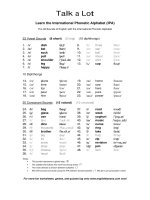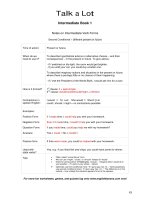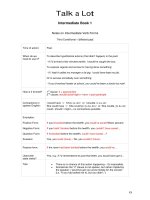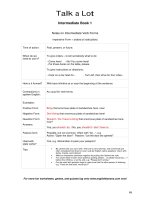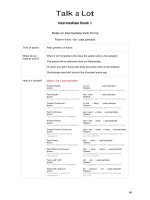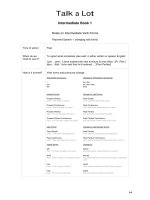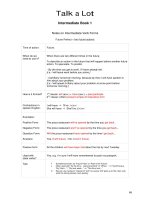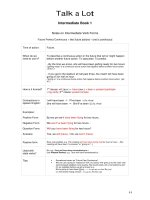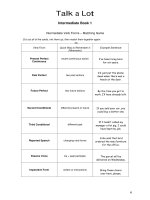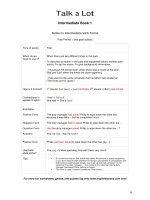talkalot intermediate book 1 phrasal verbs dice game instructions
Bạn đang xem bản rút gọn của tài liệu. Xem và tải ngay bản đầy đủ của tài liệu tại đây (464.63 KB, 2 trang )
Talk a Lot
Intermediate Book 1
Eat Up Your Phrasal Verbs – They’re Good for You!
Phrasal Verbs Dice Game – Instructions
The Phrasal Verbs Dice Game consists of the following worksheets:
P.71 Most Common Verbs and Particles Dice
Print the worksheet onto thin card. Use colour ink if possible. Cut out the dice and
score along each connecting line. Then fold the dice together and glue or tape the
tabs underneath.
When you have both dice ready, students take it in turns to roll them both together
and then use the resulting phrasal verb with some of the 57 quick activities from the
Eat Up Your Phrasal Verbs activity list (from P.51). The aim of the dice game is to
create random phrasal verbs which can then be analysed. This particular pair of dice
will make 34 different phrasal verbs, e.g. “go out” – see P.72 for the full list – and
even more if you have two particle dice and make three-word phrasal verbs, e.g. “put
back down”. The six verbs have been specially chosen because each is used in many
different phrasal verbs. Similarly, the six particles have been chosen as among the
most commonly occurring phrasal verb particles in English. To make the game more
fun, you could award points for successfully completing a task.
A simpler, more informal activity would be to get students to roll the dice and then
discuss the resulting phrasal verb – its meaning(s), translation, and the situation and
context in which it could be used.
It can be interesting to choose an individual verb and then roll only the particle dice,
making up to six different phrasal verbs. Similarly, you could choose one particle and
roll only the verb dice – and look for possible connections between phrasal verbs that
use the same particle.
Note: there may be a few occasions when no phrasal verbs are made when you roll
both dice, e.g. “give down” is not a valid phrasal verb.
P.73 Object Dice
These dice can be used with the main game (above). Students roll the verb, particle,
and object dice and discuss whether they can use the object with the resulting
phrasal verb – and where that object can go – or whether there is no object (the blank
face of the dice). For example:
“give up” + “sth” = give something up (e.g. stop smoking)
“give up” + “him” = give him up (e.g. stop thinking about an ex-lover)
“come back” + “it” = impossible. “come back” is intransitive and does not need an
object.
“come back” + “no object” (blank face of the dice) = possible: “come back” (return)
For more fun worksheets, games, and quizzes log onto www.englishbanana.com now!
69
Talk a Lot
Intermediate Book 1
Eat Up Your Phrasal Verbs – They’re Good for You!
Phrasal Verbs Dice Game – Instructions
This activity is intended to get students talking about whether phrasal verbs take an
object (transitive) or not (intransitive) – and if they do take an object, where that
object can go: either between the verb and particle or after the particle (separable), or
only after the particle (inseparable).
There is also a blank dice on this page with which you can create your own verbs,
particles, or objects dice.
P.74 Two Blank Dice
This worksheet gives students or teachers the opportunity to design and print their
own verb, particle, or object dice. You can tailor the activity to focus on the phrasal
verbs in a particular unit, or indeed any group of phrasal verbs that you need to
practise.
For more fun worksheets, games, and quizzes log onto www.englishbanana.com now!
70
